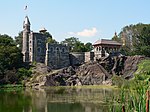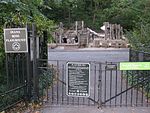Romeo and Juliet (Hebald)
1978 establishments in New York City1978 sculpturesBoyle Heights, Los AngelesBronze sculptures in CaliforniaBronze sculptures in Central Park ... and 8 more
California sculpture stubsNew York (state) sculpture stubsNew York City stubsOutdoor sculptures in Greater Los AngelesOutdoor sculptures in ManhattanStatues in New York CityStatues of fictional charactersWorks based on Romeo and Juliet

Romeo and Juliet is an outdoor bronze sculpture depicting Romeo and Juliet by American artist Milton Hebald, located in front of Delacorte Theater in Manhattan's Central Park, in the United States. It is one of two companion works at the theater sculpted by Hebald, the other being The Tempest (1966). Unveiled in 1977 and cast in 1978, Romeo and Juliet was donated by philanthropist George T. Delacorte, Jr. The sculpture is 7 feet (2.1 m) tall; the two figures, shown embracing, are set on a granite pedestal. A cast from the same mold appears in the rose garden at the Hollenbeck Palms retirement community in Boyle Heights, Los Angeles.
Excerpt from the Wikipedia article Romeo and Juliet (Hebald) (License: CC BY-SA 3.0, Authors, Images).Romeo and Juliet (Hebald)
West Drive, New York Manhattan
Geographical coordinates (GPS) Address Website Nearby Places Show on map
Geographical coordinates (GPS)
| Latitude | Longitude |
|---|---|
| N 40.78014 ° | E -73.96879 ° |
Address
Delacorte Theater
West Drive
10024 New York, Manhattan
New York, United States
Open on Google Maps










